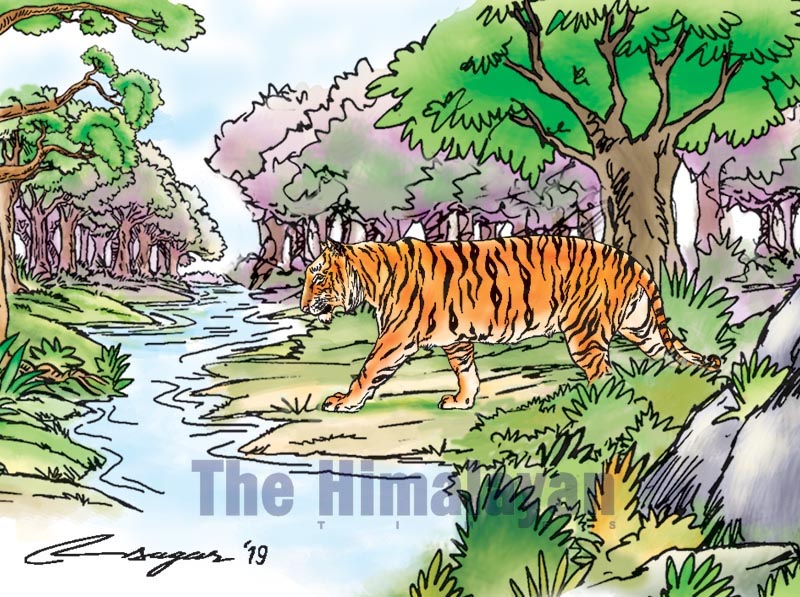Tourism in key tiger reserves: Involve local communities
There is a need to empower the disadvantaged local communities to involve them in the tourism business. Studies indicate that most of the businesses are owned by outsiders, and the locals are getting only some low-income jobs. This can be improved by empowering the local communities through development of skills in tourism- related business
Tourism plays a significant role in the economy and development of Nepal. A report prepared by World Travel and Tourism Council says that the contribution of the travel and tourism sector in Nepal’s Gross Domestic Product (GDP) was about 8 per cent in 2018, and about one million jobs had been created.
The report further states that about Rs 241 billion in revenue had been generated from the tourism industry.
Nepal’s protected areas have a substantial role in the development of tourism and local development.
In 2019, Nepal received about 1.2 million tourists. Previous records show that about 60 per cent of these tourists visited Nepal’s protected areas.
Currently, Nepal has 20 protected areas of different categories - national parks, wildlife reserves, conservation areas and hunting reserves.
Based on the number of visitors, Chitwan National Park, Annapurna Conservation Area, Sagarmatha National Park, Langtang National Park and Bardia National Park are the top priority destinations.
Bardia National Park (BNP) and Chitwan National Park (CNP) are the two key tiger reserves in Nepal. They both are biodiversity hotspots. The common fauna found in these national parks are the Bengal Tiger, leopard, Asian elephant, greater onehorned rhinoceros (not native to BNP), sambar deer, spotted deer, hog deer and wild boar. The Tharus were the only inhabitants of these lowlands of Nepal till the 1940s where these parks are located. After the successful eradication of malaria in the 1950s, hill migrants began to settle in these lowlands. Currently, the Tharu communities are in a minority.
Annually about 150,000 visitors visit these two national parks. The visitors mostly come to these two national parks to see the tigers, rhinos, culture, birds and natural landscape. Particularly in Bardia, most of the visitors want to see the tiger as their first choice and then the elephant whereas in Chitwan, the rhinoceros is the prime attraction followed by the tiger.
This indicates the significance of tiger tourism.
Based on the 2018 census, these two national parks hold 77 per cent of the total tiger population of the country. The total tiger population was estimated at 235, according to the2018 census.
According to the data held by the Department of National Parks and Wildlife Conservation, the average number of visitors (including domestic tourists) in Bardia National Park and Chitwan National Park from FY 2064/65 to 2073/74 were approximately 10,000 and 138,000 per year respectively.
The revenue through sale of entry tickets and jungle safari permit to the park visitors in FY 2072/73 was about Rs 2.43 million for BNP and Rs 11.69 million for CNP. According to the current buffer zone management policy, 30-50 per cent of this revenue goes to the local community for conservation and development activities.
A study conducted by this author found that, on average, an international visitor spends 2.8 nights while the domestic visitor spends 1.4 nights per visit in Bardia or Chitwan. The average cost (for accommodation, nature guide and jungle safari) for an international visitor is Rs 4,136 per night and for a domestic visitor Rs 2,694 per night. The average for both international and domestic visitors would be Rs 3,354 per person per night.
If calculated for a year, considering the average number of visitors, the total expenditure in BNP would be Rs 33.54 million and for CNP Rs 462.85 million. This revenue collected by tourism business owners (mostly hoteliers and a few souvenir stores) has created many employment opportunities, including safari guides, elephant and jeep drivers, cooks, room attendants and clerks. During the tourist season, every facility hires about 10-15 staff members to serve the visitors.
In the buffer zones of both the national parks, currently there are more than 300 hotels in operation.
Therefore, approximately about 2,800 to 4,200 people find employment for about six months, and approximately one-third of the staff work year-round.
This data does not include home stay facilities, which number about 64 in the buffer zone of these two parks.
Based on reports prepared by the tourism business owners, on average, a tourism business owner earns a net profit of Rs 400,000 annually from the tourism business after excluding all kinds of costs. In addition, the local communities also earn money by selling their products (farm and agriculture).
In addition, visitors spend large sums of money on international travel.
Foreign visitors on average spend about Rs 112,000 per person per visit on international travel while the average local travel cost is about Rs 14,000 to visit either of the two parks. However, the international travel costs do not contribute to the local economy. This money mostly goes to the airlines and travel companies. But some portion of the local travel costs may find its way to the local level in the buffer zone.
Tourism can be a good opportunity for the surroundings of these national parks, and the local communities are getting some relief indirectly from the money spent on conservation, such as livestock and crop loss and resource use restriction. However, there is a need to empower the disadvantaged local communities to involve them in the tourism business. Previous studies have indicated that most of the businesses are owned by outsiders, and the locals are getting only some menial and low-income jobs. This can be improved by empowering the local communities through development of skills in tourismrelated business.
Home stay facilities may be a good model of tourism to provide direct income to the disadvantaged communities, such as women, Tharus and other low-income groups while helping to preserve the local cultural heritage.
Bhattarai has previously worked in several protected areas of Nepal


